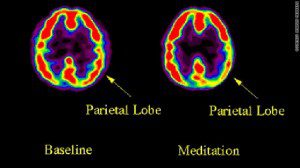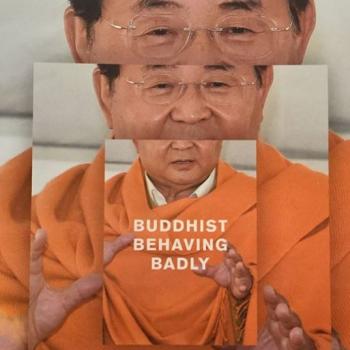 One of the very endearing aspects of Buddhism for many Westerners is the Buddha’s encouragement that we “come and see” for ourselves. It is, in the early texts at least, a religion of practice, of personal cultivation, and intellectual curiosity and satisfaction.
One of the very endearing aspects of Buddhism for many Westerners is the Buddha’s encouragement that we “come and see” for ourselves. It is, in the early texts at least, a religion of practice, of personal cultivation, and intellectual curiosity and satisfaction.
It’s a religion for idiots who screw up a lot, but who aren’t afraid to keep trying and are willing to work at it. In my early years as a Buddhist, through the help of a succession of wonderful meditation teachers, I was very earnest in my meditative practice. These days I’m quite lazy about it. I’ll either have to pick it up again to solve the mystery below, or I can rely on your helpful suggestions and experiences.
My last post was about a lecture by Prof Richard Gombrich, in which he talks briefly about the Buddhist meditation states known as the jhanas. This spurred an interesting and ongoing conversation between myself and Doug Smith, who writes for the Secular Buddhist Association.
You can listen to or download (by right-clicking) Prof Gombrich’s talk here. At about 27 minutes in, he discusses the jhanas – meditative absorptions (sometimes called ‘trances’ but this is misleading).
Have a listen.
The ‘Cliffs Notes’ version of that section of his talk go as follows:
- In the 1st jhana: you have to have first rid yourself of all sensual desires and other ethical fetters of the mind. Here you have vitakka – thinking and vicara – examining, along with delight and happiness (piti & sukha).
- In the 2nd jhana: vitakka – thinking and vicara – examining disappear. The mind is now one-pointed: ekodibhāvaṃ. Gombrich argues that here there is no thought. (Here there is still delight and happiness)
- In the 3rd jhana: delight and happiness are replaced by equanimity, upekkhā. One-pointedness is no longer mentioned, and instead the meditator is said to be sato ca sampajāno, aware and cognizant.
- In the 4th jhana: equanimity and awareness are purified upekkhāsatipārisuddhiṃ (parisuddhim being ‘purified’).
Prof. Gombrich then admits that what comes next might be a bit controversial. He suggests that the 3rd and 4th jhanas are quite unlike the 2nd. He suggests the thought experiment: would a meditator (in any of these states) notice a flashing light or loud noise in his/her vicinity. Gombrich thinks that in the 3rd/4th he would notice but in the 2nd he wouldn’t.
What comes next is a bit technical, but basically, the later tradition lumps these all in the service of ‘calming’ meditation, which is then opposed to the more advanced ‘insight’ meditation practice. What Prof Gombrich (I believe) is suggesting, is that in fact these 3rd and 4th jhanas are more akin to ‘insight’ practice then to ‘calming.’
He then discusses recent neurological findings regarding the activity of the left and right brain. The right side is our ‘awareness’ side, roughly speaking, while our left side is our linguistic and ‘analysis’ side. This is a simplification (there are whole books and plenty of journal articles to read to find out the ins and outs of left-right brain interaction), but Gombrich’s point is that the 2nd jhana develops the analytical side of the left brain to it’s peak, and then shifts to right-brain awareness in the 3rd/4th jhanas.
~
Gombrich is quite aware that his comments are preliminary here, but he urges us to (re)-understand the Buddha’s teaching in our own vocabulary, which for many these days is that of neuroscience.

Doug Smith, mentioned above, alerted me to one of his teachers, Leigh Brasington, a virtual treasure-trove of practice and analysis of the jhanas. But he also questioned Gombrich’s understanding of what actually happens in the jhanas (from an admittedly ‘beginners mind’ point of view).
This is where your input would be helpful. The more I think about it, and recollect those early days when I did experience some of these states with regularity, the more I doubt Gombrich’s suggestion that the 3rd and 4th jhanas are really phenomenologically (experientially) different from the first two.
But – maybe. Maybe the first two jhanas are the process of ‘honing’ the analytical side of the brain – or silencing it, or focusing it… The image that comes to mind most for me is something like making oneself into a drill — or perhaps a diver on a high-jump. The key is entering in – one-pointedly and fully immersing yourself; but at some point you ‘break through’ in a way and experience expansiveness, a sort of ‘kung-fu’, 360 degree awareness that can only really work because the analytic side has been so perfectly focused that it simply drops away.
Yet, according to tradition, the jhana meditations are done with an object, so even when one-pointedness drops away, the attention is still in the object. Check out the many links compiled by Leigh Brasington for a great discussion of this fact.
So two issues arise here:
- Was the early tradition* correct to interpret that some object of meditation is needed? (Brasington suggests that they were not.)
- Is there a clear ‘break’ between the 2nd and 3rd jhanas, further glossed over by the tradition, that we need to re-examine?
* The distinction here is between ‘what the Buddha said’ (generally isolated to the Sutta and Vinaya Pitaka) as opposed to later commentarial traditions, which reached their height in Buddhaghosa’s Vissudhimagga or “Path to Purification”.











